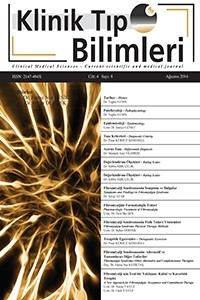Karşılıksız Aşk ‘de Clerambault Sendromu’: Bir olgu sunumu
Öz Erotomani, hakkında 1921'de geniş kapsamlı bir inceleme belgesi (Les Psychoses Passionelles) yayınlayan Fransız psikiyatrist Gaëtan Gatian de Clérambault'dan (1872-1934)sonra Clérambault sendromu olarak da adlandırıldı. De Clérambault sendromu; bireyinözgül bir şekilde başka birinin kendisine aşık olduğuna inandığı, ayrıntılı ve düzenli sanrıyla belirgin nadir görülen bir sendromdur. Sanrı genellikle cinsel bir çekicilikten çok manevi bir bağlanma ve romantik bir aşkla ilgilidir. Hastalar çoğunlukla orta sınıftan kadınlardır. Sözde sevgili genellikle; daha yaşlı, ekonomik ve sosyal açıdan daha yüksek sınıftan, evli ve hastaya uygun olmayan bir bireydir. Belirtilerin başlangıcı ani olabilir ve sıklıkla kişinin yaşamının temel odağı haline gelir. Hipokrat zamanından beri bilinmesine karşın, ilk kez De Clerambault tarafından tanımlanan bu bozukluğun nasıl başladığına, seyri, tedavisine ilişkin bilgiler sınırlıdır. Çalışmamızda; 52 yaşında, ilkokul mezunu, işsiz, dul ve hekimin kendisine aşık olduğuna ilişkin sanrı geliştiren bir kadın has-ta nedeniyle sendromun etiyoloji, klinik ve tedavi açısından tartışılması amaçlanmıştır.
Anahtar Kelimeler:
De Clerambault sendromu, erotomani, klinik, tedavi
De Clérambault’s Syndrome: A Case Report
AbstractErotomania is also called de Clérambault's syndrome, after the French psychiatristGaëtan Gatian de Clérambault (1872–1934), who published a comprehensive review paper on the subject (Les Psychoses Passionelles) in 1921. De Clérambault’s Syndromeis a syndrome whose hallmark is an elaborate, rare, systematized delusion; specifically,the patient becomes convinced that she or he is passionately loved by another person.In general, the delusion is associated with romantic love rather than sexual attraction.The patients are usually women from modest backgrounds, while the percevied loversare generally older men of distinctly higher social and financial status who are almostinevitably married and unavailable. The onset of the symptoms can be sudden and often becomes the central focus of the affected person’s life. Although it has not been knownsince the time of Hippocrates, information on the course, treatment, and treatment of how this disorder was first described by de Clerambault is limited. This paper discusses aetiological, clinical and treatment aspects of the syndrome with reference to a typical casewho is 52 [year]s, widowed, unemployed, graduated from primary school and has a delusion that she was loved by a physician.
Keywords:
De Clérambault’s Syndrome, erotomania, clinical, treatment,
___
- Kaynaklar 1. Berrios GE, Kennedy N. Erotomania: a conceptual history. HistPsychiatry. 2002;13(52 Pt 4):381–400. 2. Kasantikul D. Erotomania in Thai patients: a study of 20 cases. J MedAssoc Thail. 1998;81(11):852–7. 3. Signer SF. “Les psychoses passionnelles” reconsidered: a review ofde Cl??rambault’s cases and syndrome with respect to mood disor-ders. J Psychiatry Neurosci. 1991;16(2):81–90. 4. Jordan HW, Howe G. De Clerambault syndrome (erotomania): a re-view and case presentation. J Natl Med Assoc. 1980;72(10):979–85. 5. Kennedy N, McDonough M, Kelly B, Berrios GE. Erotomania revi-sited: Clinical course and treatment. Compr Psychiatry.2002;43(1):1–6. 6. Rudden M, Sweeney J, Frances A. Diagnosis and clinical course oferotomanic and other delusional patients. Am J Psychiatry.1990;147(5):625–8. 7. Enoch MD TW. Uncommon Psychiatric Syndromes, Ed. 3. Bristol,England: Wright. 1991. 8. Segal JH. Erotomania revisited: From Kraepelin to DSM-III-R. Vol.146, American Journal of Psychiatry. 1989. p. 1261–6. 9. Mullen PE, Pathe M. The pathological extensions of love. Br J Psychi-atry. 1994;165(NOV.):614–23. 10. Guirguis WR. Pure erotomania in manic-depressive psychosis. BrJ Psychiatry. 1981;138(2):139–40. 11. Wood BE, Poe RO. Diagnosis and classification of erotomania (I).Vol. 147, American Journal of Psychiatry. 1990. p. 1388–9. 12. Gillett T, Eminson SR, Hassanyeh F. Primary and secondary ero-tomania: clinical characteristics and followup. Acta Psychiatr Scand.1990;82(1):65–9. 13. Remington G, Book H. Case report of de Clerembault syndrome, bi-polar affective disorder, and response to lithium. Am J Psychiatry.1984;141(10):1285–7. 14. Signer SF SR. Two cases of erotomania (de Cle´rambault syndro-me) in bipolar affective disorder. Br J Psychiatry. 1987;151:853–5. 15. Munro A, O’Brien J V., Ross D. Two cases of “pure” or “primary”erotomania successfully treated with pimozide. Can J Psychiatry.1985;30(8):619–22. 16. Lovett Doust JW, Christie H. The pathology of love: Some clinicalvariants of de clérambault’s syndrome. Soc Sci Med Part A MedPsychol Med. 1978;12(C):99–106. 17. Evans DL, Jeckel LL, Slott NE. Erotomania. A variant of patholo-gical mourning. Bull Menninger Clin. 1982;46(6):507–20. 18. El-Assra A. Erotomania in a Saudi woman. Br J Psychiatry.1989;155(OCT.):553–5. 19. Garland M, McGennis A. Primary and secondary erotomania: Is thedistinction worthwhile? Ir J Psychol Med. 1998;15(1):22–3. 20. Koi E. d, Dordevi V., Filakovi P., Vondraek S., Nad S. Erotoma-nia treated with risperidone. Acta Clin Croat . 2007;46(3):251–4. 21. Alao AO, Armenta W, Yolles JC. De clerambault syndrome success-fully treated with olanzapine [4]. Vol. 34, Annals of Pharmacothe-rapy. 2000. p. 266–9. 22. Kojeve A. Köle-efendi diyalektiği. Çev. Bumin T. Defter. 1988. 6:7-29. 23. LACAN J. The Seminar of Jacques Lacan, Book XI: The Four Fun-damental Concepts of Psychoanalysis [Internet]. Jacques-Alain Mil-ler, trans. Alan Sheridan (1977. 1977. 1-306 p. 24. Dunlop JL. Does erotomania exist between women? Br J Psychiatry.1988;153(DEC.):830–3.
- ISSN: 2147-494X
- Başlangıç: 2013
- Yayıncı: Selen Medya Yayıncılık Tanıtım ve Organizasyon Hizmetleri
Sayıdaki Diğer Makaleler
Migren Tipi Baş Ağrısının Psikiyatrik Yönü
Gardner Diamond Sendromu: Olgu Sunumu
Karşılıksız Aşk ‘de Clerambault Sendromu’: Bir olgu sunumu
Az bilinen bir konu ‘Kleptomani’: Bir Olgu Sunumu
Pedofili İle Obsesif Kompulsif Bozukluğun Ayırıcı Tanısı: Olgu Sunumu
